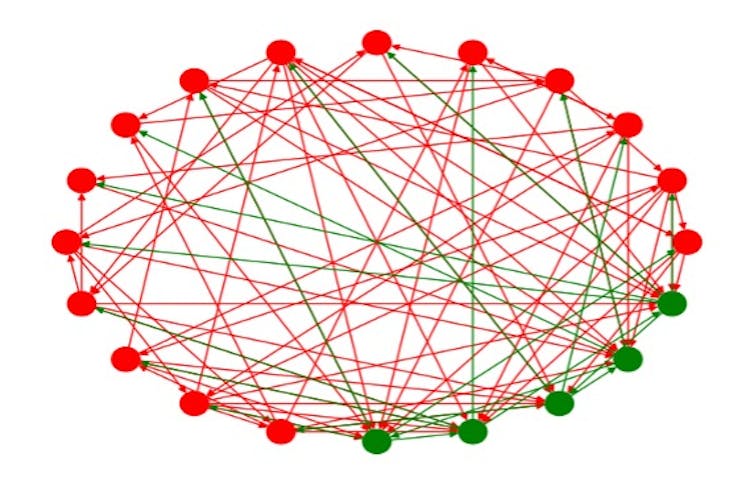The original version of this article was published in french in the conversation see here
The brain is an essential organ for the functioning of the human body and coordinates our interactions with the outside world. Reasoning, sensory, cognitive and emotional flows, decision-making, memory mechanisms… Most human activity is reflected in the brain.
Made up of approximately 86 billion neurons connected to each other by synapses 10,000 times more numerous, the brain controls the body through a permanent electrochemical symphony. But how do individual neurons communicate with each other to provide an adequate global response?
To answer this question, it seems necessary today to combine the research of neuroscientists, physicists and mathematicians.
An article recently published in the journal Nature shows for example how the brain of the fly performs vector calculations to manage its orientation in the two-dimensional plane during its flight. This research has highlighted a real-time synchronization of the neuronal activity of certain areas of the brain, as well as their correspondence in terms of vector calculation, to allow the fly to orient itself in the plane.
Groups of neurons synchronize
In general, two phenomena appear to be unavoidable today when one wishes to study the activity of groups of neurons in the brain: synchronization and the emergence of rhythms.
[Plus de 80 000 lecteurs font confiance à la newsletter de The Conversation pour mieux comprendre les grands enjeux du monde. Abonnez-vous aujourd’hui]
For networks made up of similar elements, such as the brain, synchronization refers to the idea of a coherence of activity between the different elements of the system. Several types of synchronization are observed in physical systems and in nature. For example, it is possible to observe groups of fireflies which emit light signals in a synchronized manner or schools of fish or swarms of birds which synchronize their movements.
Read more:
The Butterfly Effect: What’s Behind Chaos Theory?
We speak of “complete synchronization” when all the elements of the system evolve in the same way over time. This is the most striking synchronization. This type of synchronization corresponds for example to an assembly of metronomes which, placed on a wooden board sitting on soda cans, will synchronize their oscillations in an identical way, as in this video.
In the brain, the synchronizations are different and more subtle.
And a rhythm emerges
The rhythms that emerge can be identified: they correspond to frequencies, as if the neurons took on the role of metronomes. The brain abounds with examples of the emergence of synchronizations and rhythms: for example, the visual cortex V1 system, an area at the back of the brain that receives visual signals, is much studied.
Read more:
Towards brain prostheses: when artificial and natural neurons dialogue
Experiments show that a gamma frequency peak (i.e. greater than 30 hertz) is observed when the visual cortex V1 is stimulated by specific visual signals, for example images with black and white lines moving in a given direction. Mathematical models made up of networks ofordinary differential equations are used to model the activity of V1.
Recent work has shown, using this type of model, how stimulation of V1 can lead to the emergence of gamma rhythms via partial synchronization of neural activity. In this case, the rhythm emerges from the increase in the number of action potentials (impulses) emitted concomitantly in subgroups of the neuronal population.
Here, it is not a question of complete synchronization, because all the neurons do not adopt an identical dynamic. Groups of neurons will over time tend to emit action potentials simultaneously, which will produce the rhythm observed in the network.
The math of the brain
This type of mathematical model consisting of a network of individual entities belongs to the category of complex systems. When we study complex systems, we typically seek to understand how, for a certain network structure, individual entities and a given level of stimulation, the variation of a parameter will allow the emergence of synchronizations and rhythms.

Benjamin Ambrosio, Provided by the author
It is the subject of a recent work carried out within the framework of a thesis, in which we considered a network of differential equations of the Hodgkin-Huxley type (a typical mathematical model of neuron), whose structure is inspired by the visual cortex V1. In this network, each differential equation represents a neuron that can excite or inhibit the electrical activity of the neurons to which it is connected.
By varying a parameter (in our case, a number quantifying the amplitude of excitation induced by the excitatory neurons towards the excitatory neurons), one can illustrate how the system evolves from an unsynchronized state to a state of partial synchronization then a very pronounced synchronization. The network frequency is a gamma type frequency.

Benjamin Ambrosio, Provided by the author
Such approaches, which use mathematics to describe frequency emergence in neural tissues, are expected to develop more and more in the future. One of the very concrete applications of these models is to calibrate the value of the parameters to allow an optimal implementation of therapeutic solutions. For example, electrical or electromagnetic stimulation techniques are widely studied in contexts such as the therapy of aphasia or disease of Parkinson.
It should be specified here that the mathematical models must adapt to the different spatial scales according to the type of measurements carried out, from the scale of the cranial surface to a few millimeters in other studies.
Nevertheless, mathematical models capable of reproducing typical frequencies measured in the brain at different scales are bound to play a crucial role in understanding the emergence of cerebral rhythms.